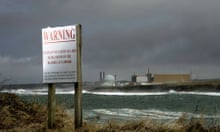The unmarked white van at an isolated farm on the fringes of the Lake District National Park attracted no attention among locals. And when a metal tripod drill was spotted, it was presumed the farmer wanted to set up a water bore hole.
But as a string of vans bearing the names of soil analysis companies and then a host of Portakabins turned up at the tiny hamlet of Kirksanton, questions began to be asked. When those living on the farm said they could not talk about it and overall-wearing site workers announced they had signed the Official Secrets Act, rumours ran riot.
Even then few guessed the truth that was finally revealed in letters from RWE: that the German energy group was "investigating the possibility" of building a nuclear power station there. Tomorrow RWE will nominate the site as part of a wider move to kickstart a nuclear revolution aimed at giving Britain more energy security and lower carbon emissions.
RWE will also suggest a site at Egremont further up the "Energy Coast" near Sellafield while EDF of France and E.ON of Germany will put forward their favoured sites for building a new generation of reactors. These companies will be scrambling to put in bids by the formal deadline tomorrow for land being auctioned off by the Nuclear Decommissioning Authority (NDA).
RWE insists its priority is to hold discussions with local representatives and groups but already villagers have held protest meetings and threatened to abandon their homes rather than accept a reactor there.
Leukaemia
"We live in a beautiful part of our world and that's all we've got here really," said Sue Abbott, whose smallholding sits alongside the site. "We are going to have major building works, light pollution, all the roads - and that will change the area completely even without the aspect of nuclear danger."
Michael Wills, a fireman whose wife's family have owned their home in the village for 54 years, said he was concerned about the future for his five children. "With our young family, growing up next to a nuclear power station would be very worrying for us. I know links to cancers and leukaemia are not proven absolutely but there is lots of evidence that there are links to nuclear power."
He said locals had been given less than a month to take part in the consultation. "It's not giving us any time to put together a credible case based on the correct facts as to why this is the wrong place for a nuclear power station."
The leader of the Millom Without parish council, Wilson Huck, said he was concerned about road links to the area, an issue that has already been raised at Sellafield. "Access is very limited and, although the council hasn't met to discuss this yet, I think we feel access is even worse than at Sellafield."
Some residents would welcome the plant, which - it is rumoured - could provide up to 600 jobs. Rosie Mathisen, energy opportunities director at West Lakes Renaissance, the urban regeneration company that has been working to attract interest in building nuclear reactors in west Cumbria, said: "We welcome RWE's commitment to nuclear new-build. Their interest in these two sites is testament to the attractiveness of west Cumbria as a place for new-build, given the area's world-renowned skills base and strong support for the nuclear industry."
Huck said he feared jobs would largely go to outside experts while existing businesses, which include an organic nursery and several bed and breakfasts, a caravan park and farms, could be blighted by the plant.
"This bizarre selection of sites for reactors in west Cumbria by RWE smacks more of sticking a pin in the map and, by a stroke of luck, coming up with something just outside the National Park boundary than any properly considered site selection process," said Martin Forwood, campaign coordinator at Cumbrians Opposed to a Radioactive Environment. "Neither site anywhere near meets the government's criteria of being at an existing nuclear site, being close to where electricity is wanted or having suitable National Grid connections.
Deadline
"Should RWE's plans go ahead, west Cumbrians can kiss goodbye to any notion of a diversified, clean and safe future for the region. With the possibility of hosting the UK's nuclear waste dump and the prospect of more reactors at Sellafield or on adjoining land owned by the NDA, the region will become the Lake District Nuclear Park - sitting dangerously alongside the much hallowed Lake District National Park."
If all goes to plan the government will hold a formal consultation on these sites this year and publish a final policy statement next spring. Energy groups will then spend three years planning and licensing locations so that building could start in 2013 and operations begin in 2018, though few independent analysts believe that deadline will be met.
Nuclear power is promising to make a comeback in Britain as well as France, the US and China at a time when some believe low-carbon alternatives such as wind and solar are not going to achieve the scale expected of them. Reactors remain deeply controversial, with concerns over cost, the threat of terrorism and the fact that radioactive waste remains toxic for hundreds of years.

